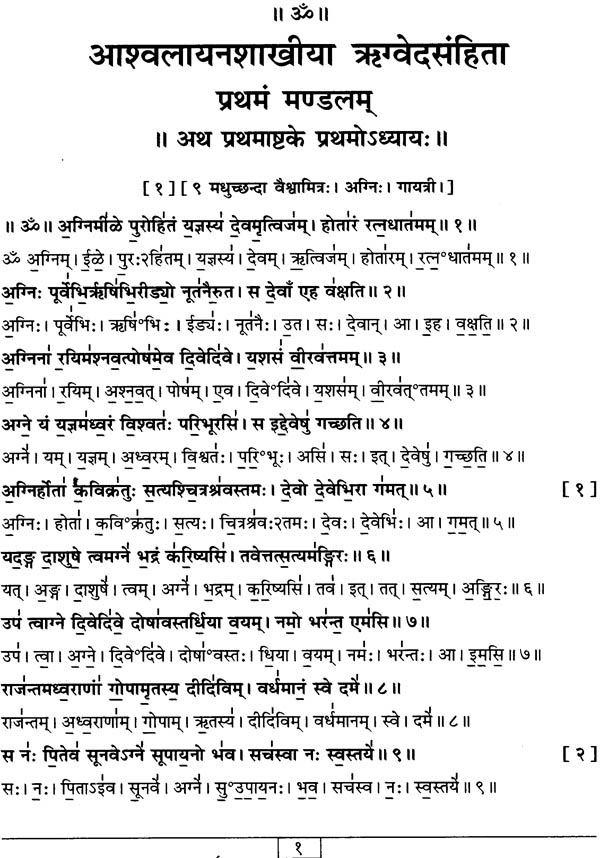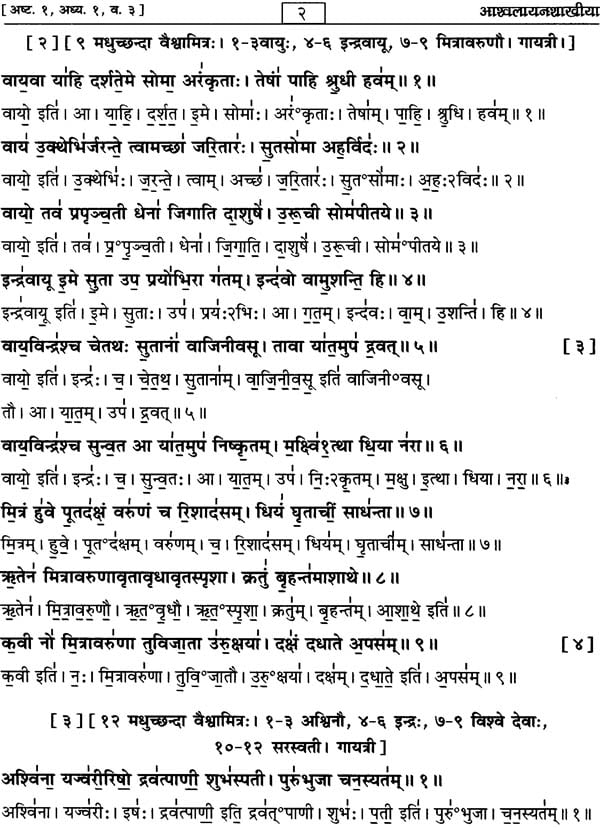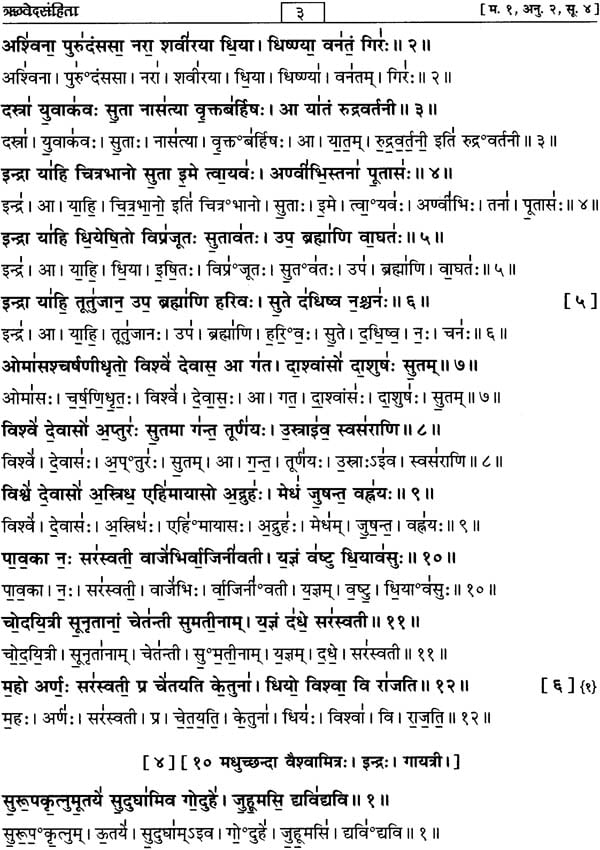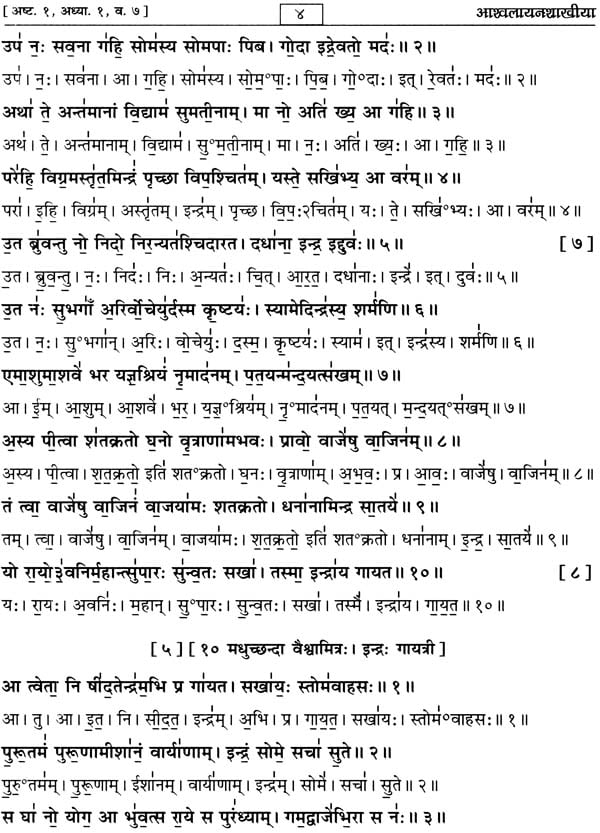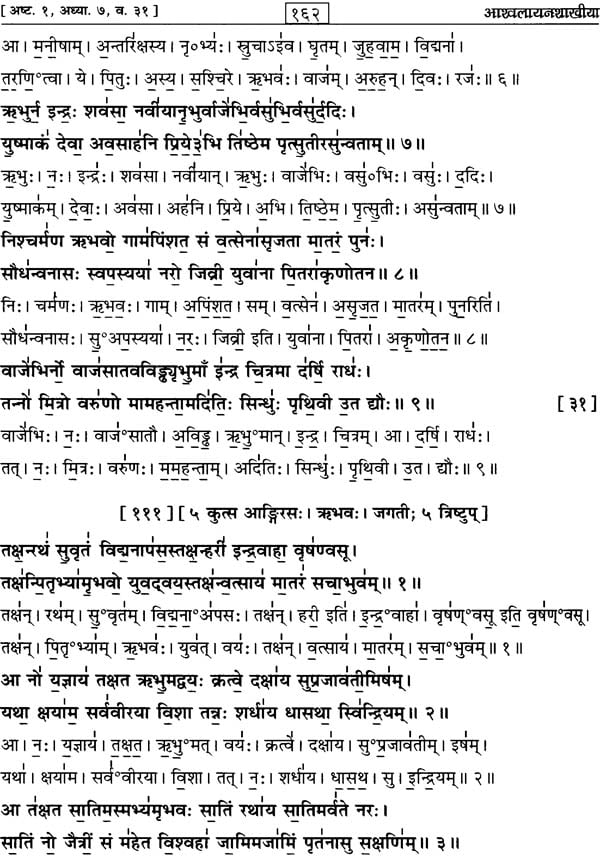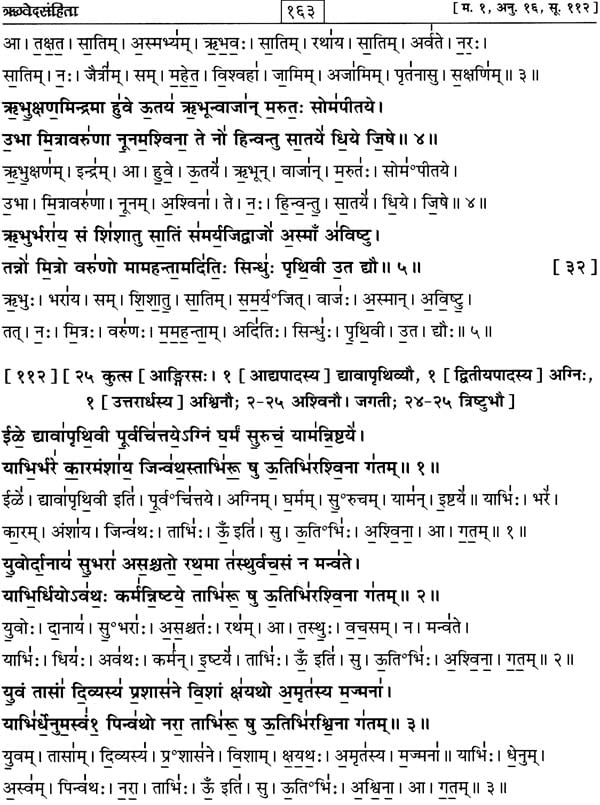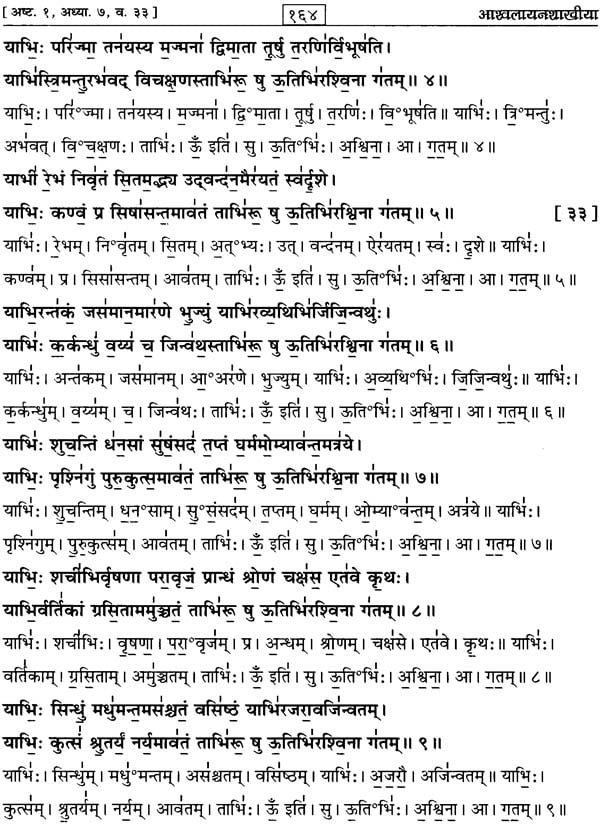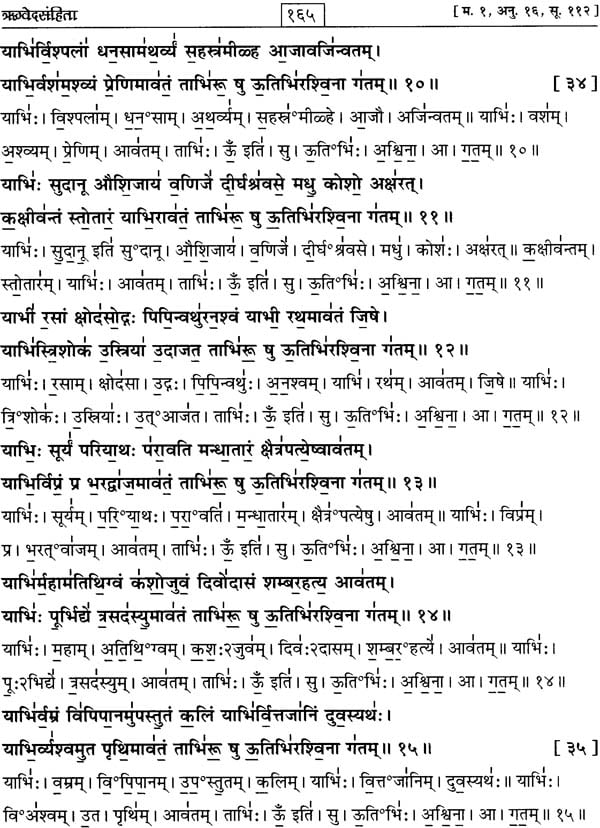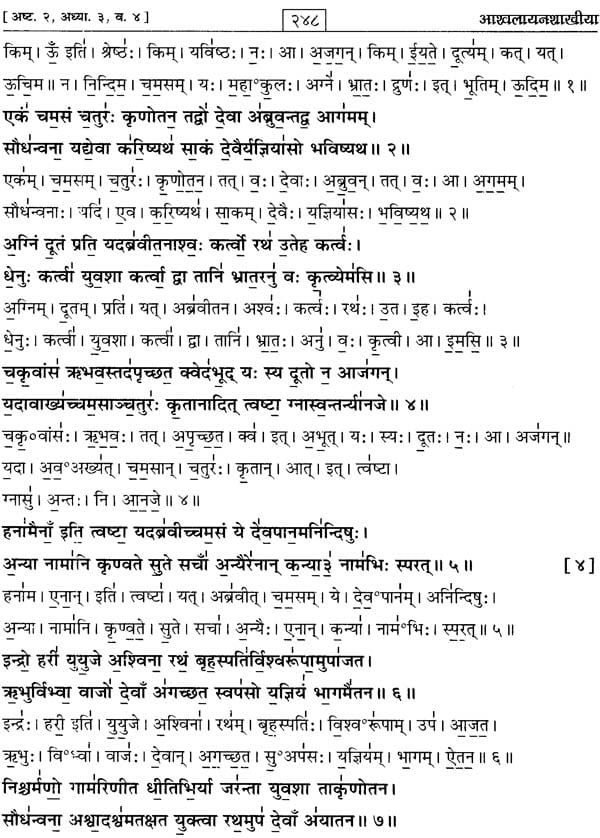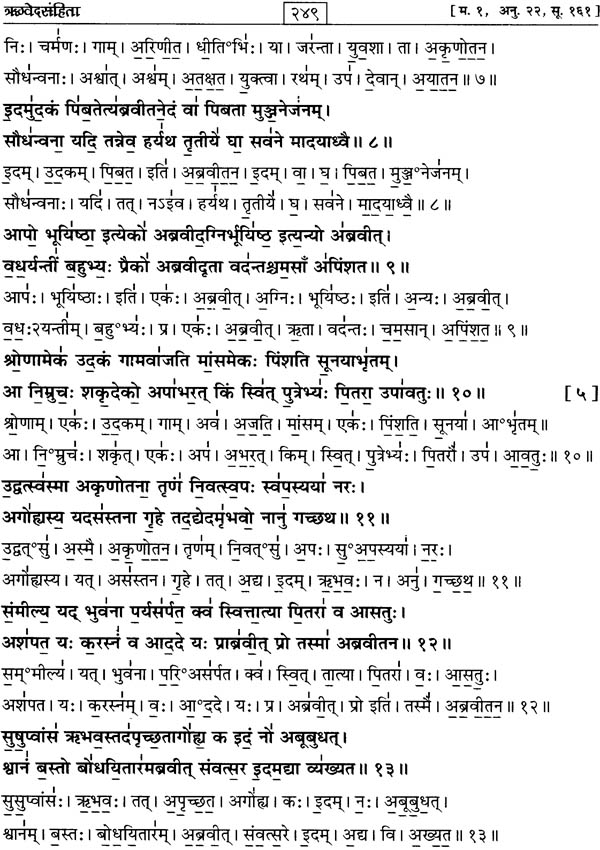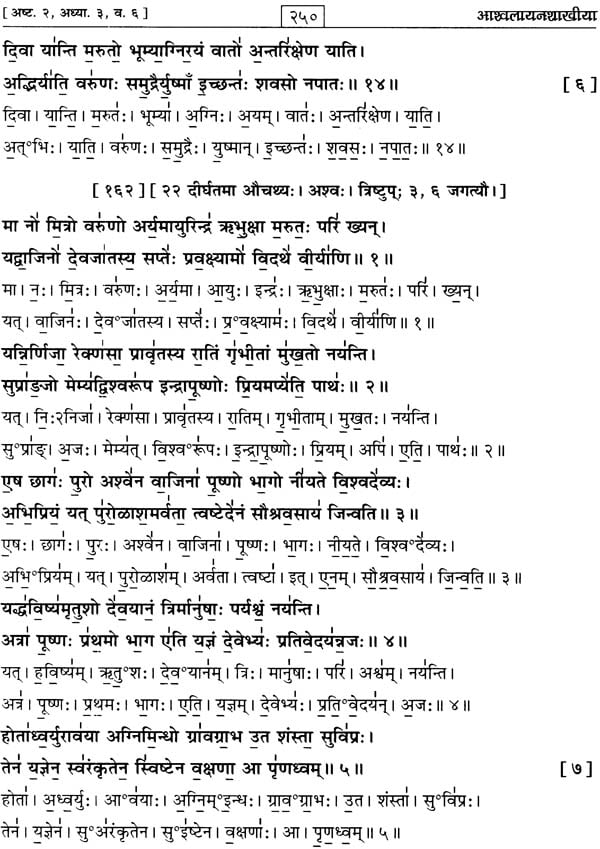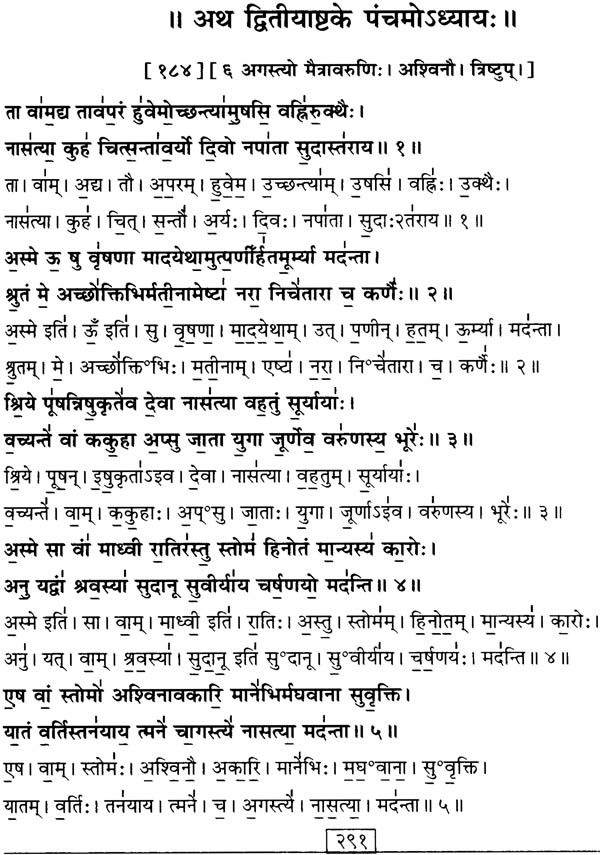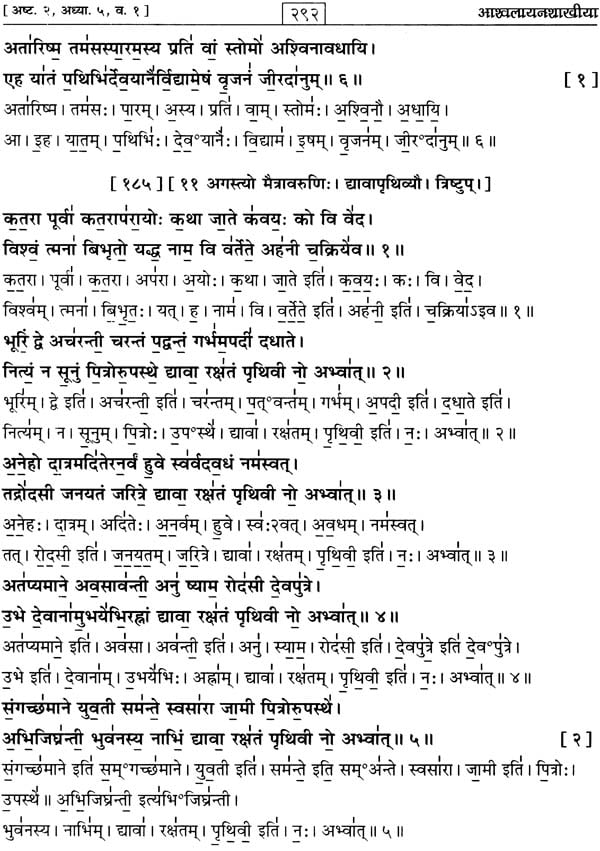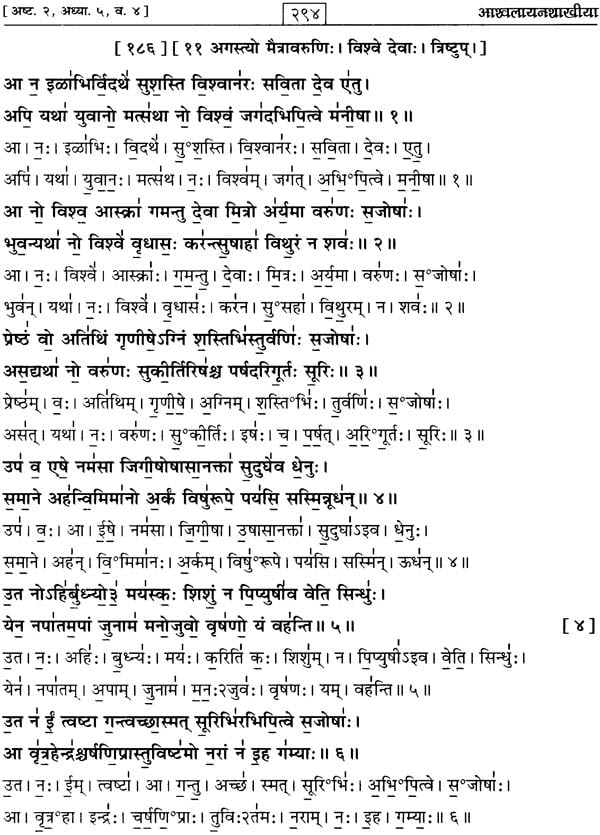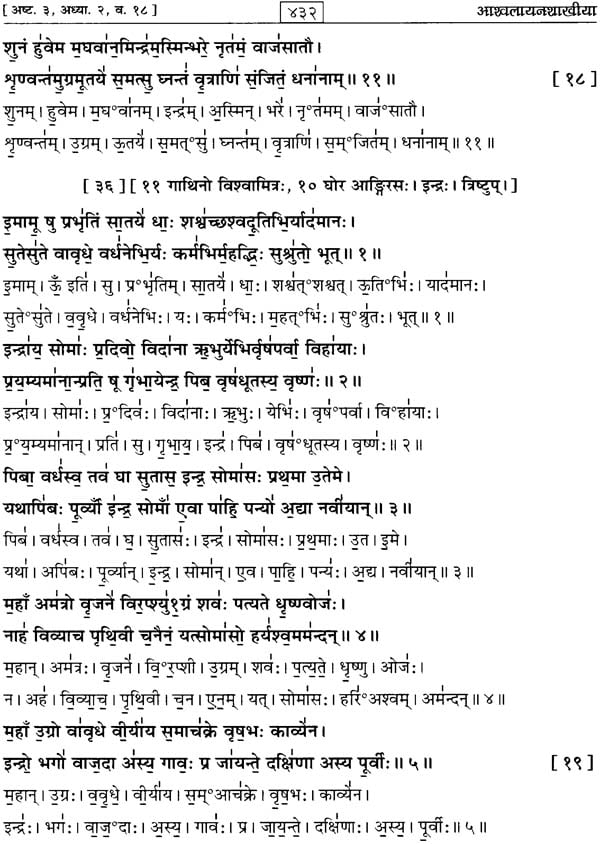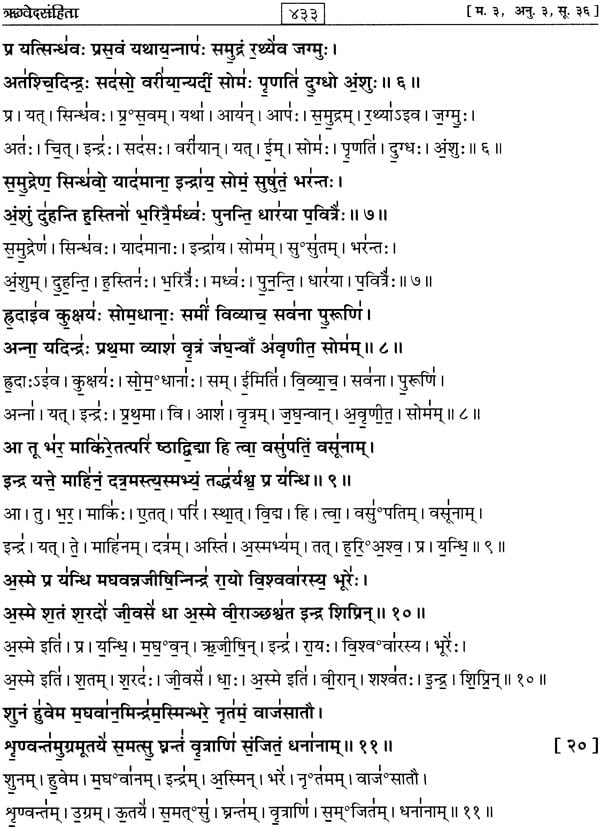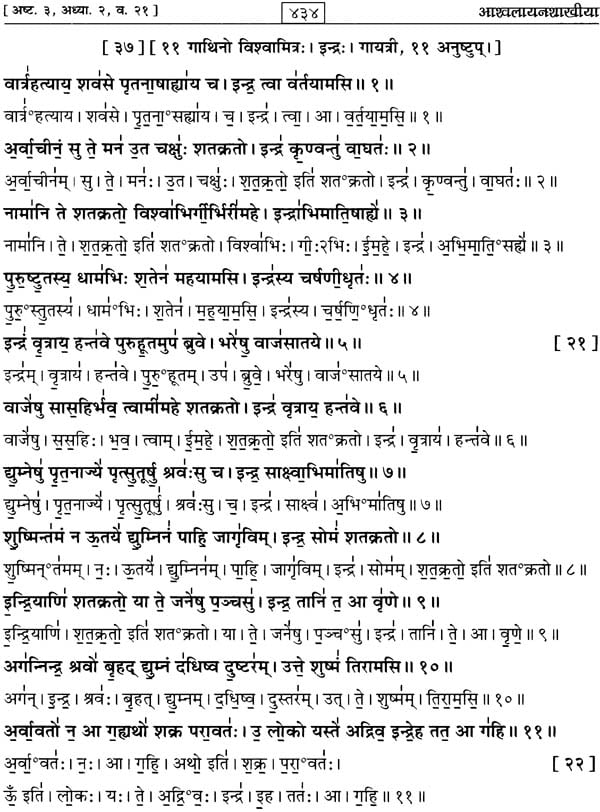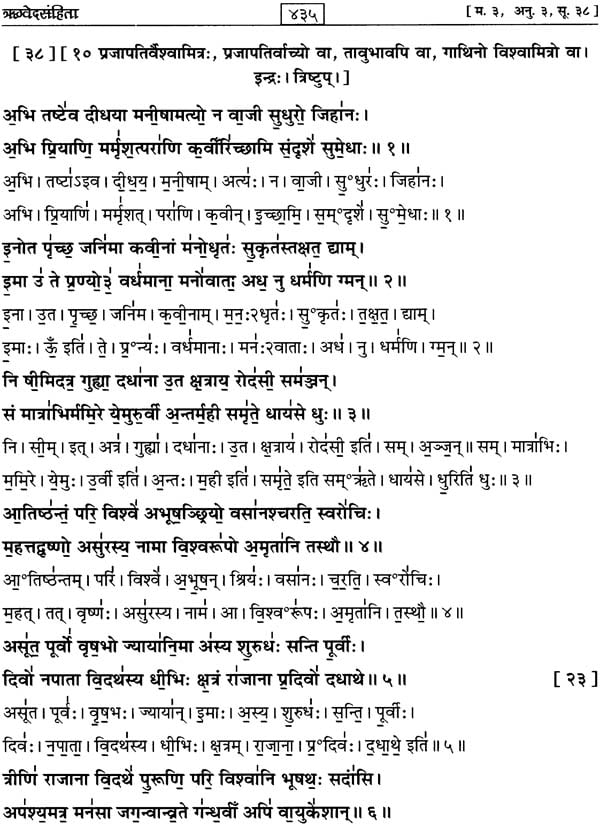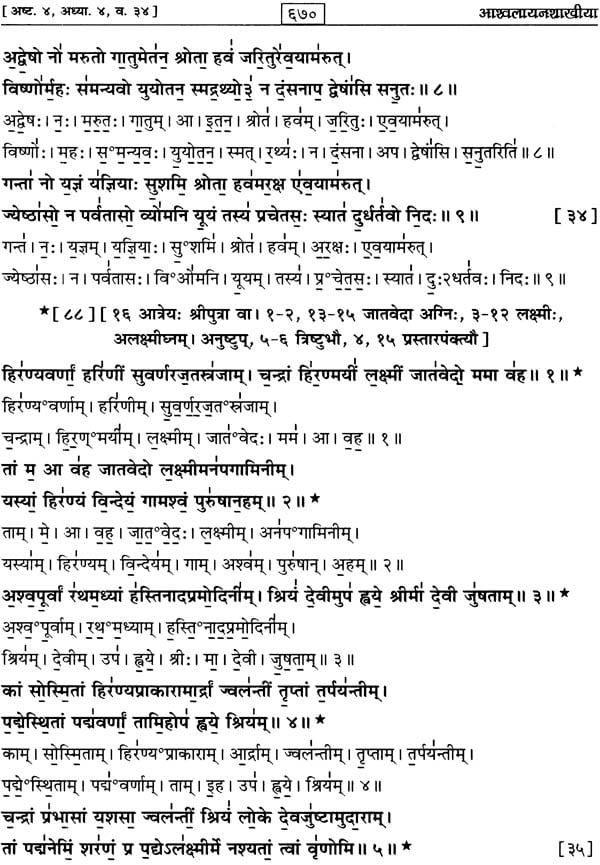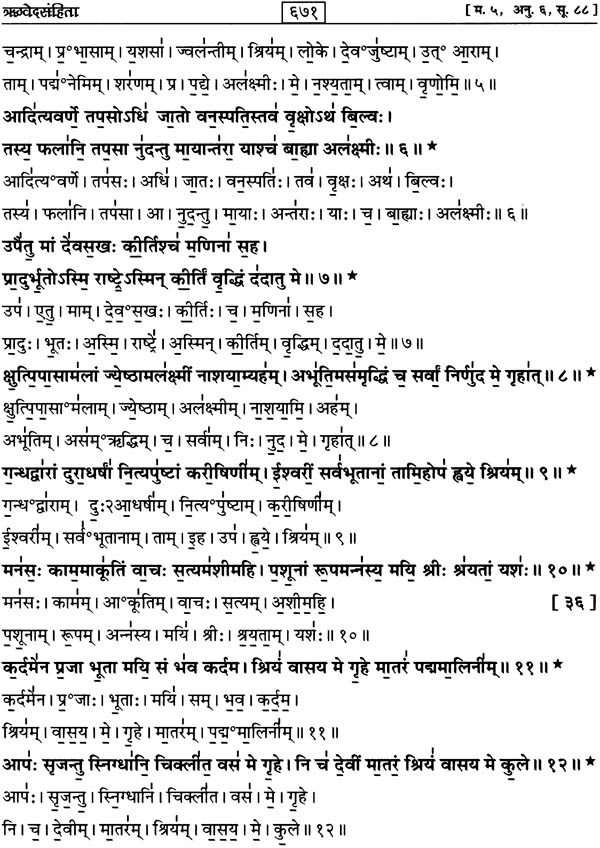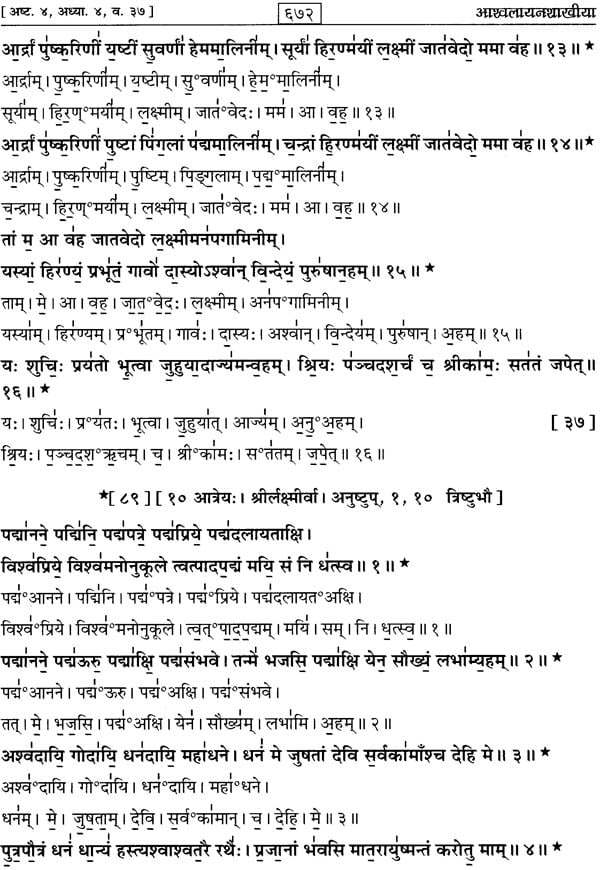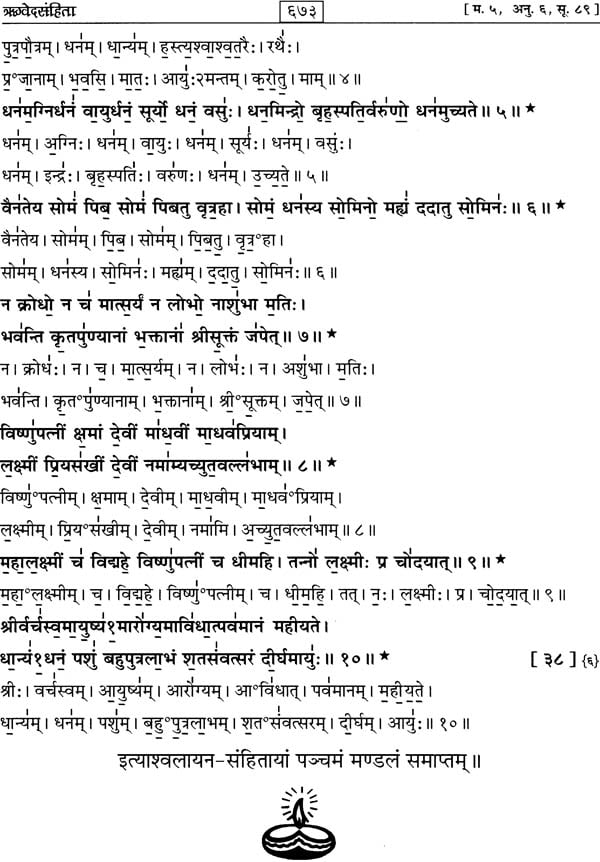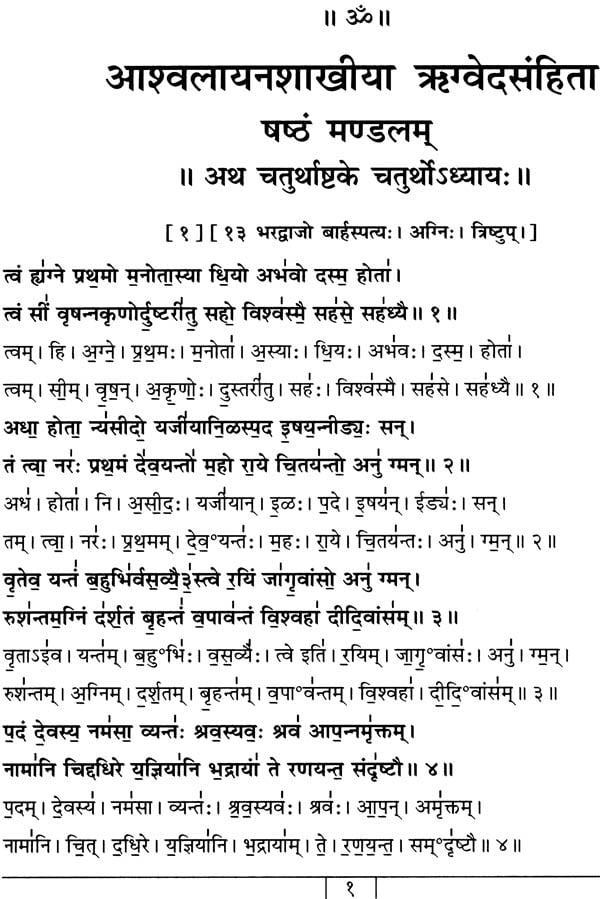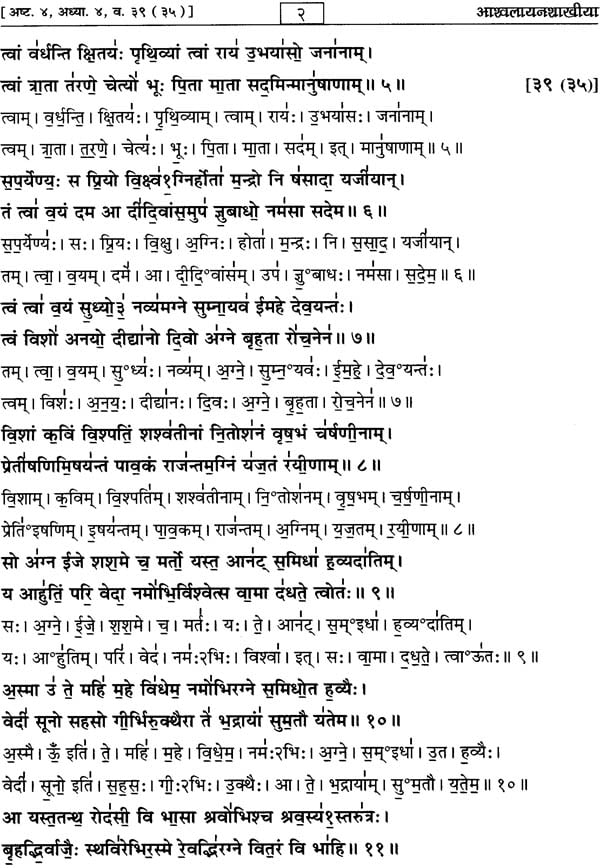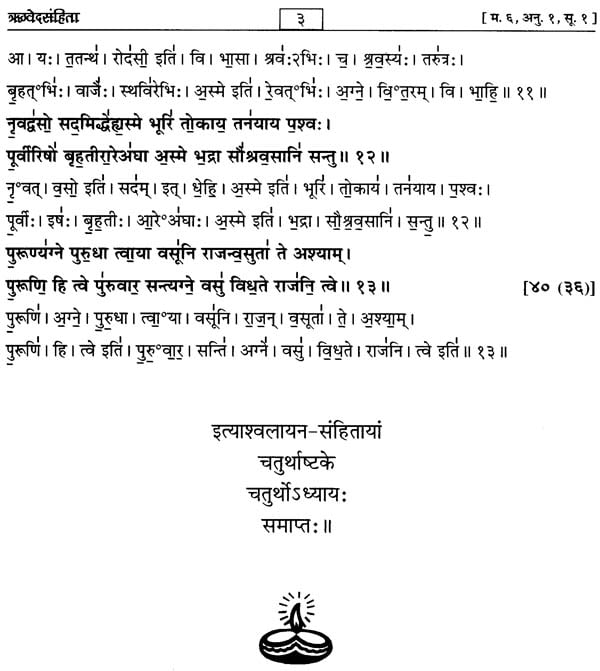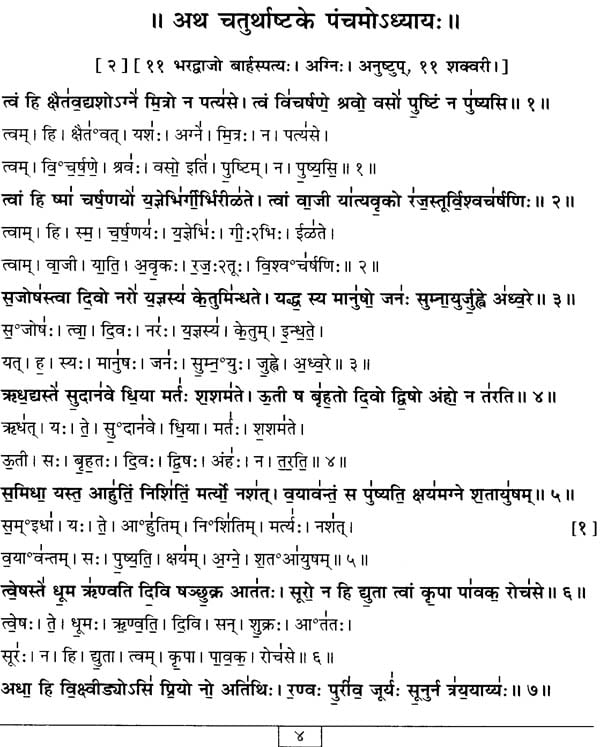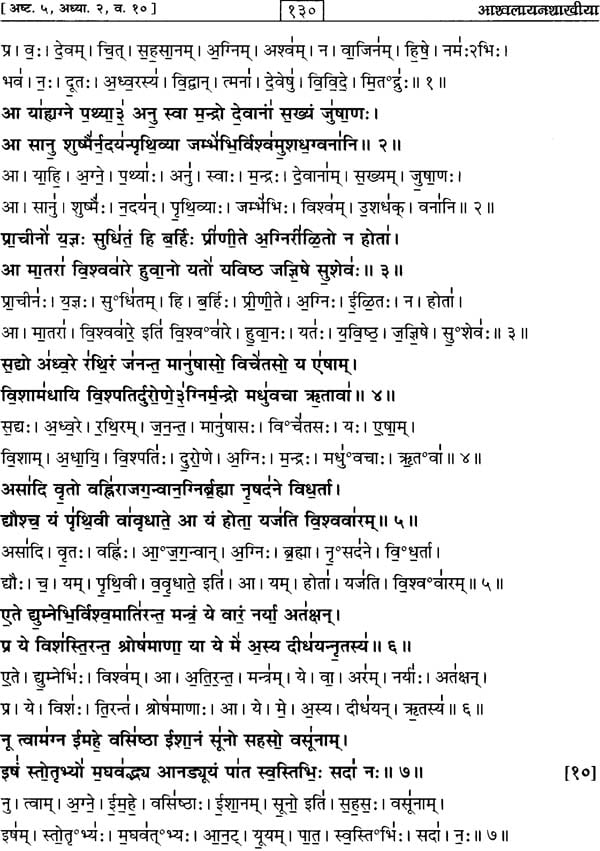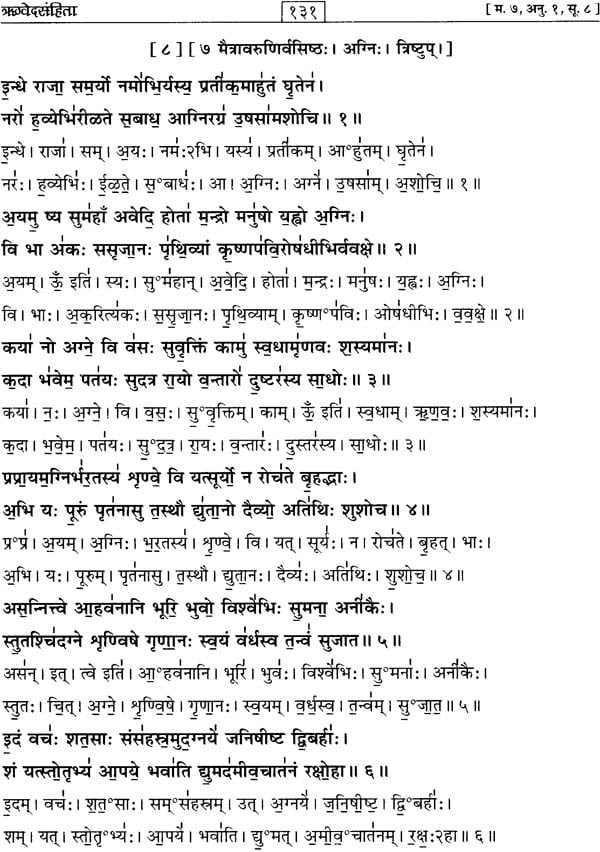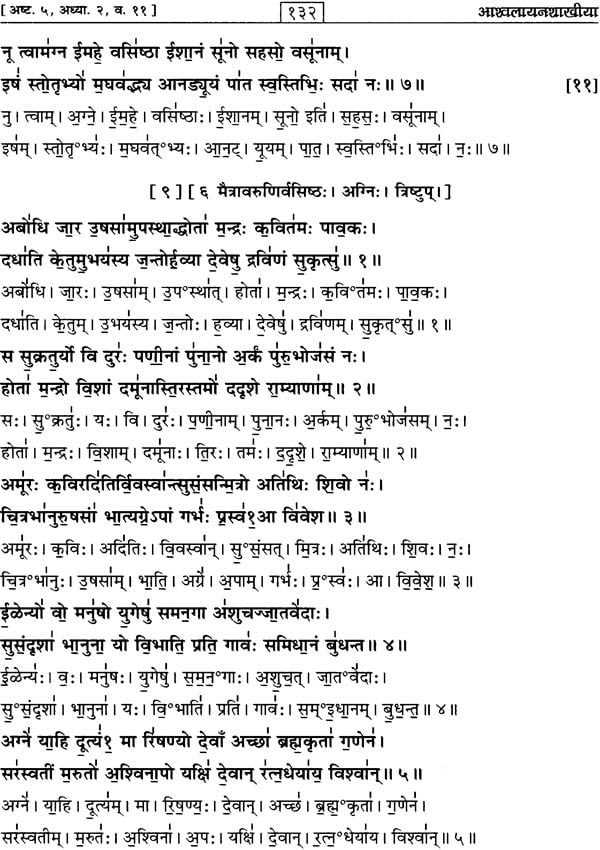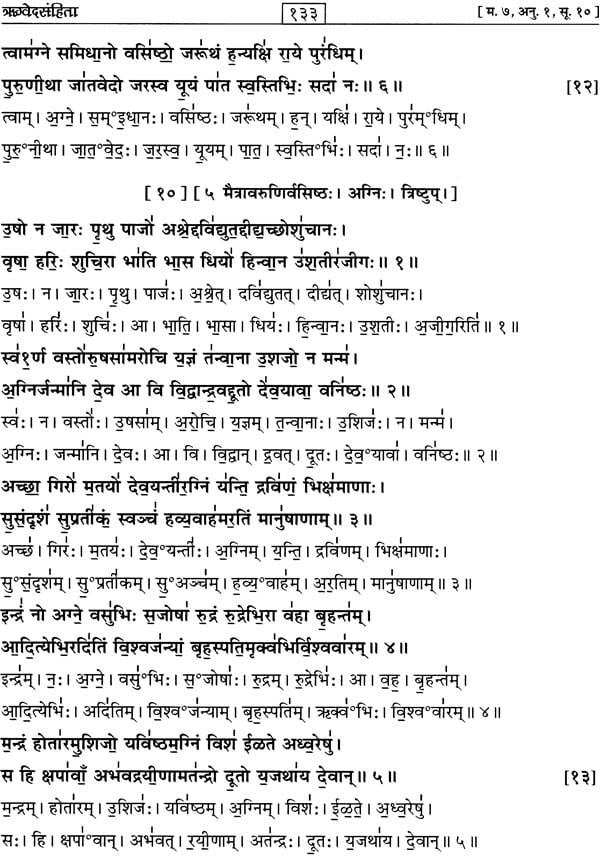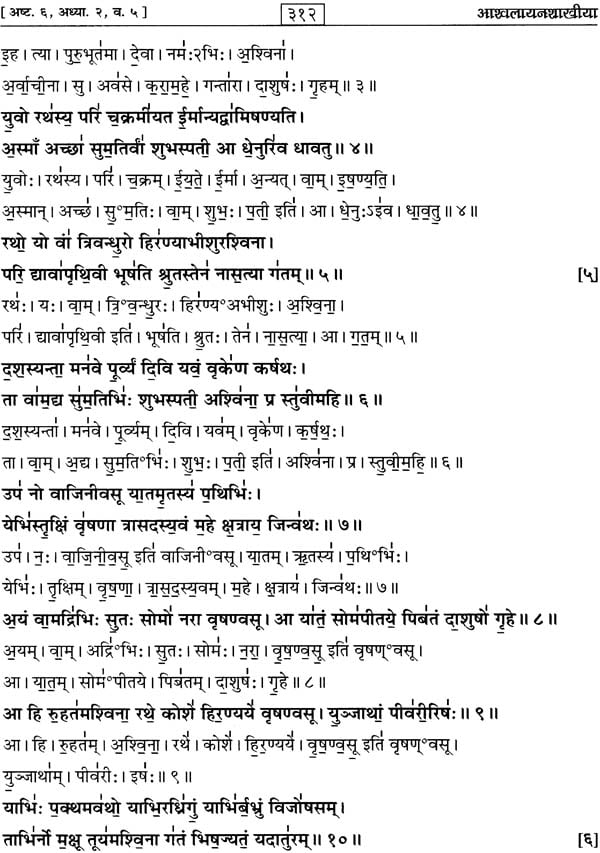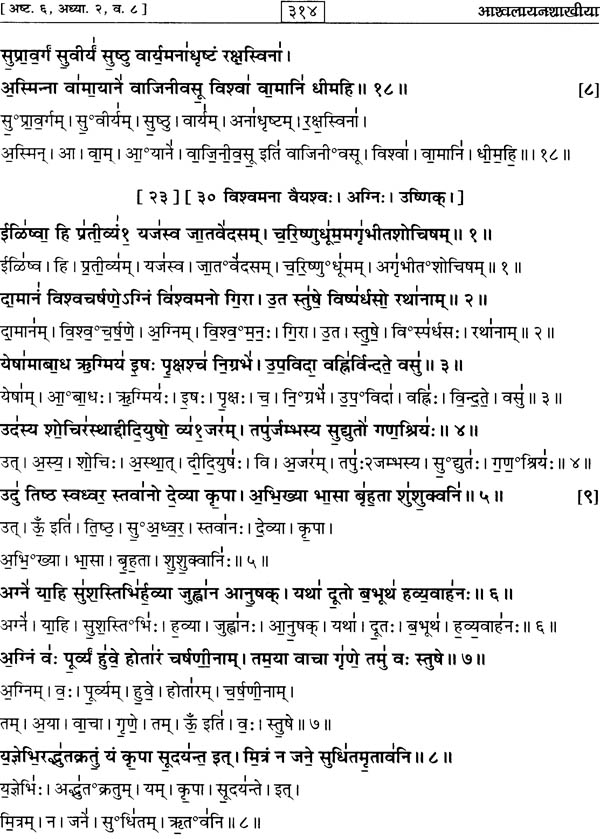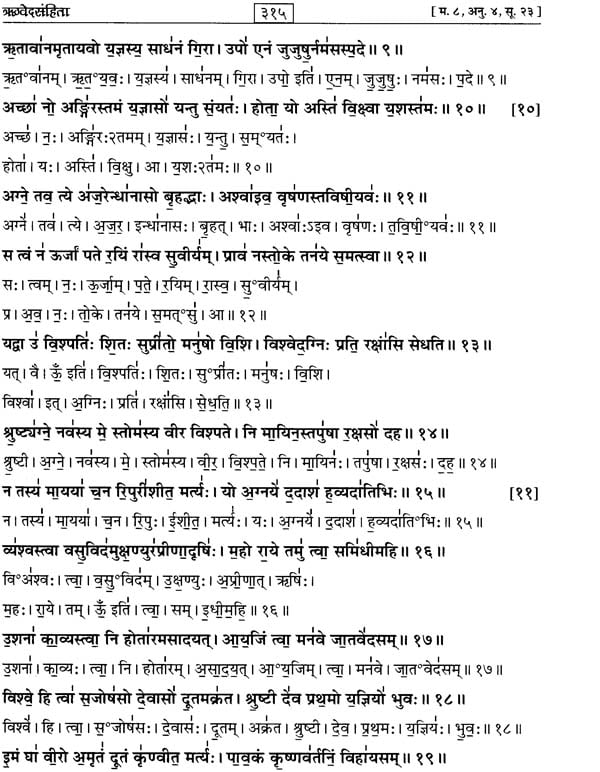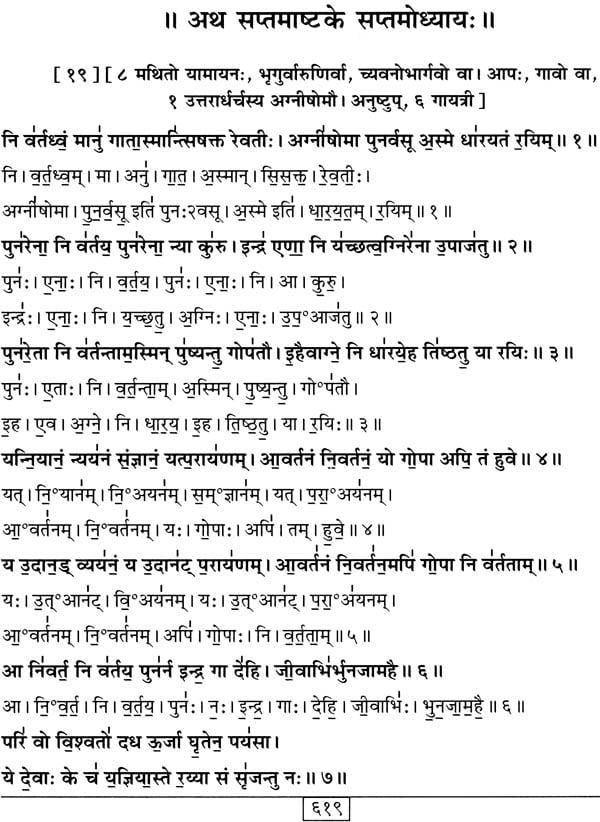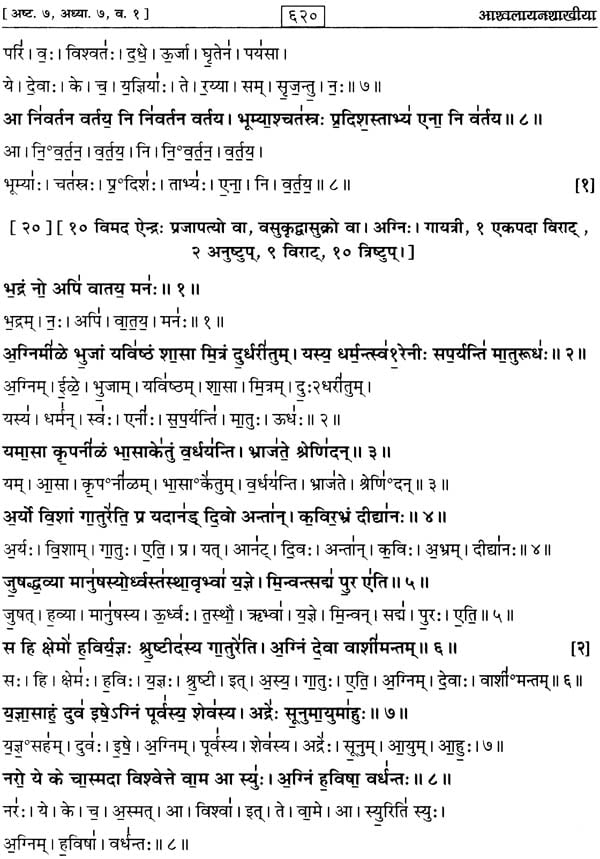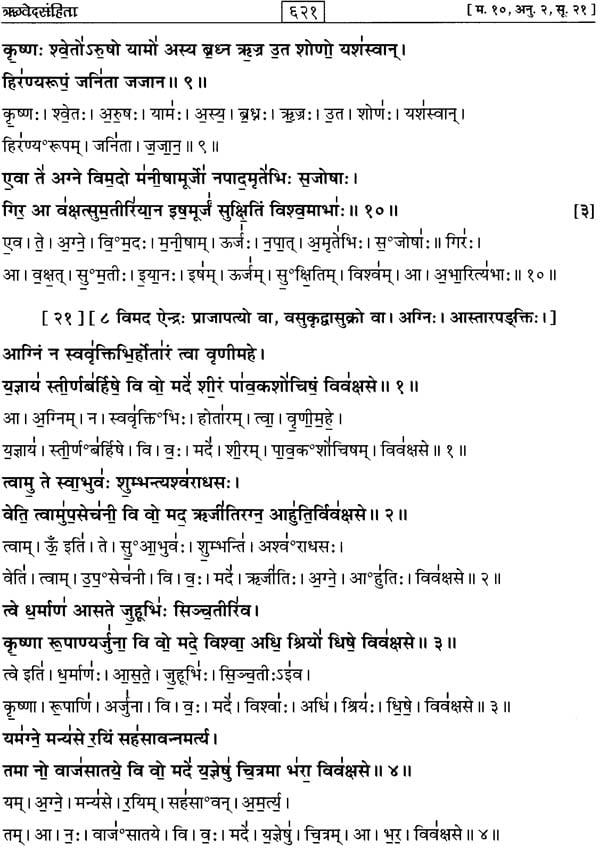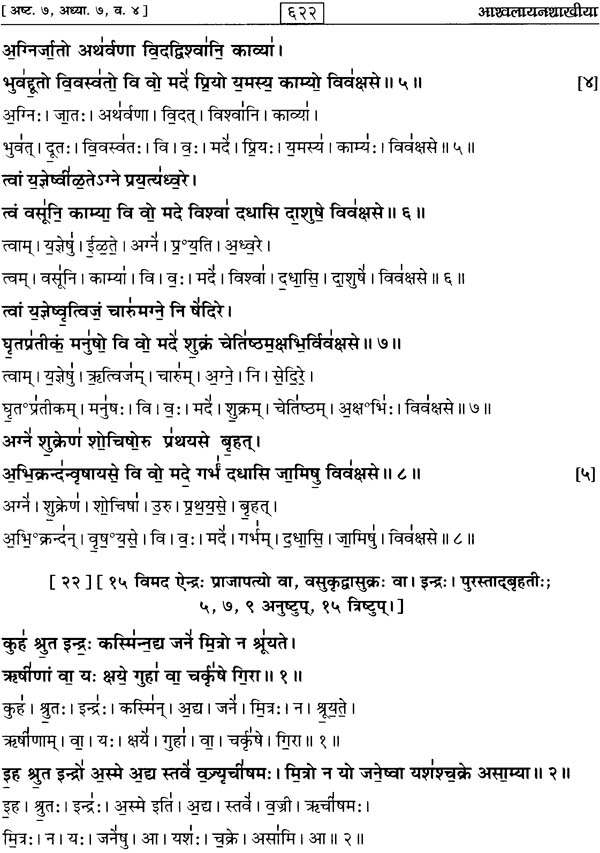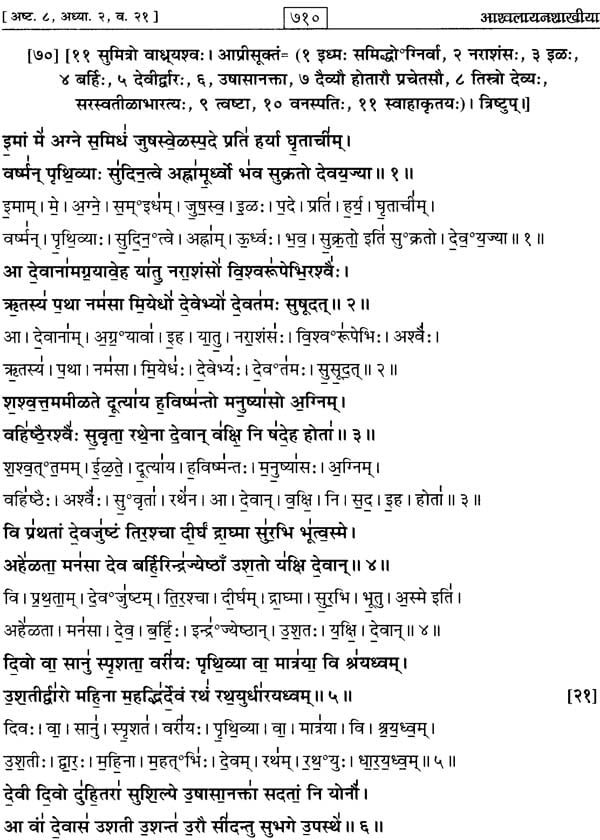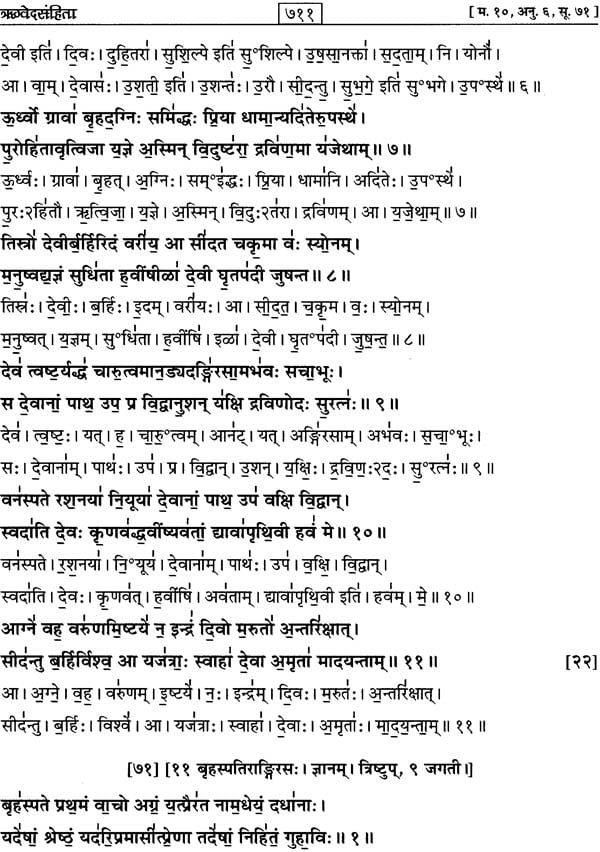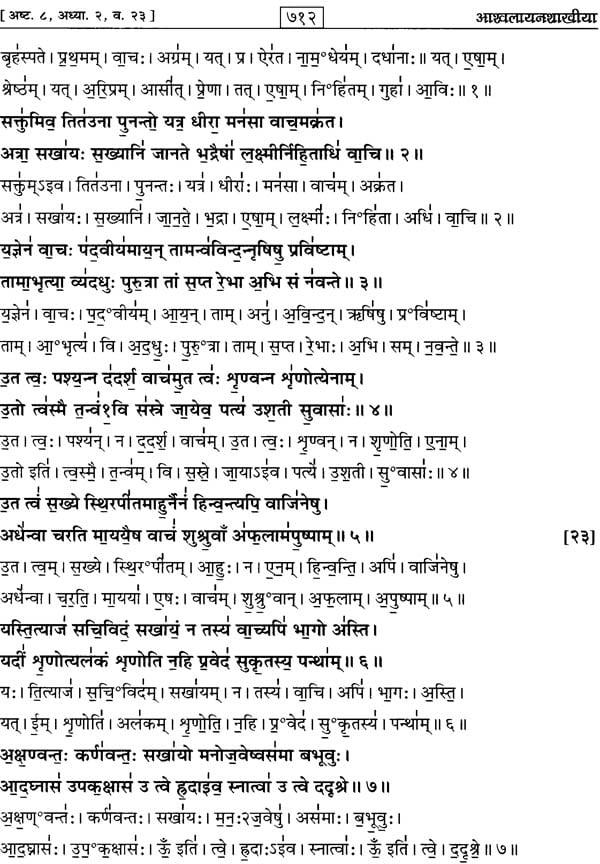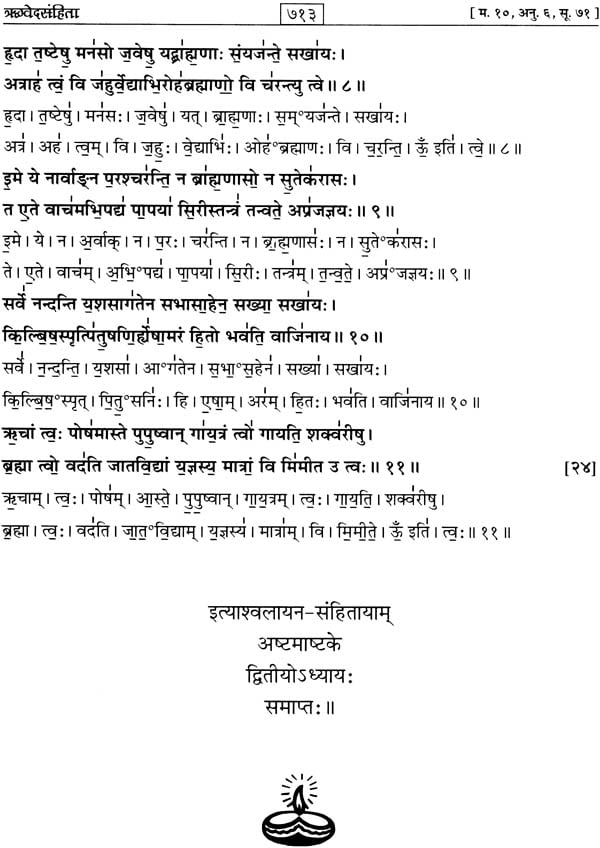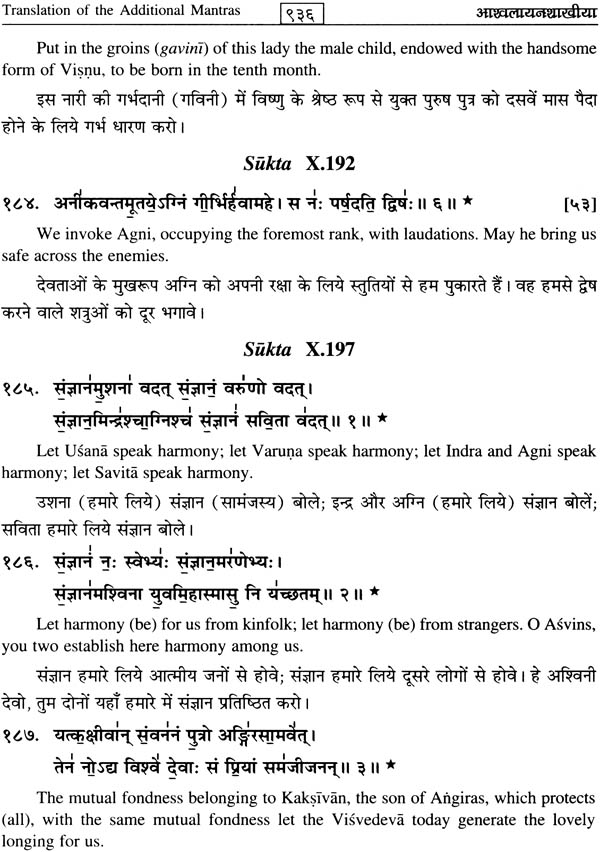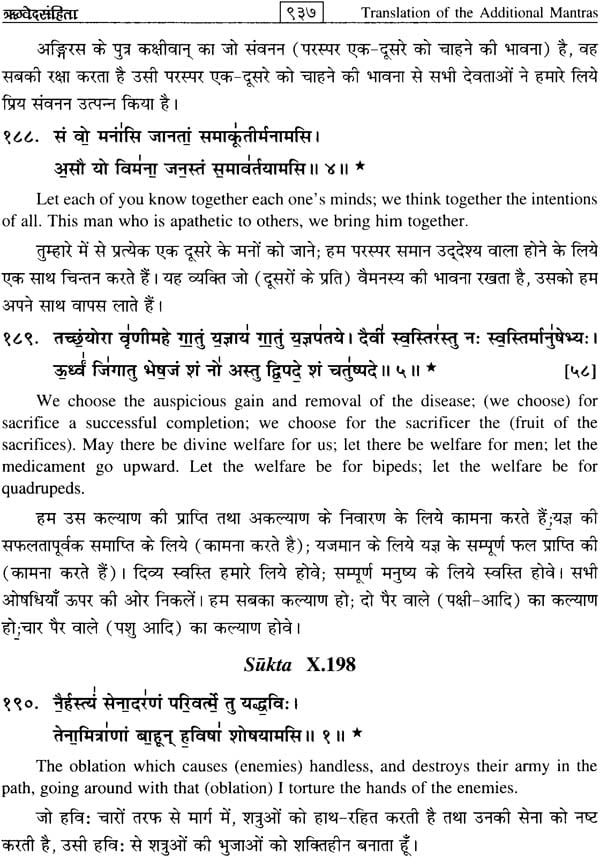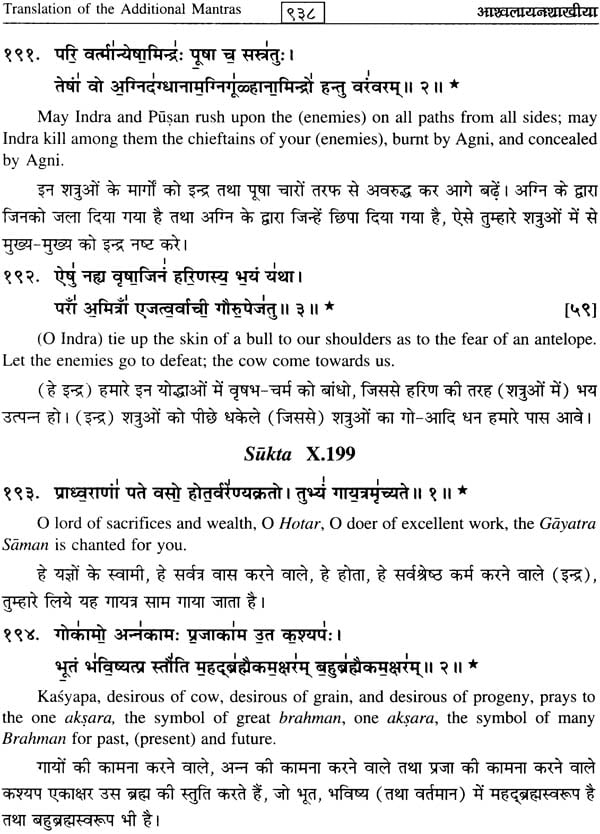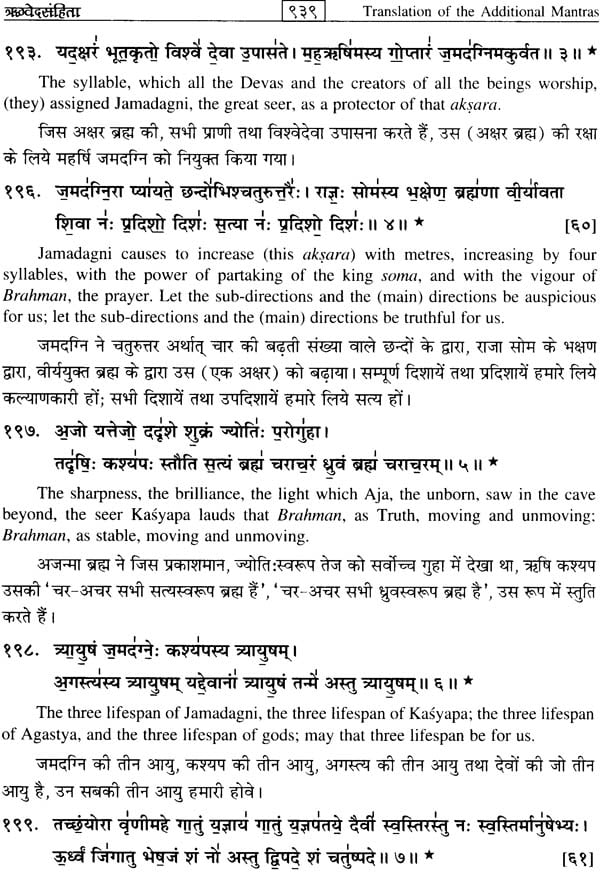
Asvalayana-Samhita of the Rgveda with Padapatha (Vol.-I Mandalas-5) (Vol.- II Mandalas 6-10) (In Two Volumes) - Sanskrit Only
Book Specification
| Item Code: | IHE087 |
| Author: | B.B. Chaubey |
| Publisher: | Indira Gandhi National Center for the Arts and D. K. Printworld Pvt. Ltd. |
| Language: | sanskrit |
| Edition: | 2009 |
| ISBN: | 9788185503172 |
| Pages: | 1959 |
| Cover: | Hardcover |
| Other Details | 9.8” X 7.4” |
| Weight | 4.70 kg |
Book Description
From the Jacket
Among the twenty-one Sakha-Samhitas of the Rgveda, as mentioned by Patanjali, only seven Samhitas were known by name and among these too, only one Sakala-Samhita was available in printed form so far. Now with the publication of the present edition of the Asvalayana-Samhita a complete picture of a new Sakha-Samhita will come to fore for the first time. In comparison to the Sakala-Samhita the Asvalayana-samhita has 212 additional mantras among which some occur in the common suktas and others form 16 additional complete suktas. Among these additional suktas special mention may be made of Kapinjala-sukta (IX.68), Hiranya-sukta (X.130), Medha-sukta (X.155) and Manasa-sukta (X.171).
The book in two volumes presents the full text of the Asvalayana Samhita of the Rgveda with Padapatha, Marked with proper accent marks. The additional mantras of the Asvalayana Samhita followed by their translation in English and Hindi are also provided at the end of the Samhita text.
In a detailed introduction of the text the learned editor has examined the existence of Sakha-Samhitas of the Rgveda as mentioned by the Puranas, Patanjali, Mahidasa and other authorities, scrutinizing textual evidence in support of them. The focus is, however, on the Asvalayana-Samhita, with a background on Acarya Asvalayana and exploring the antiquity, treatment of accent and padapatha of the text by referring to various sources.
Professor B.B. Chaubey, recipient of Certificates of Honour from the President of India, is an eminent Sanskritist and an authority on Vedic language, literature and culture. He was Professor-Director of Vishveshvaranand Vishva Bandhu Institute of Sanskrit and Indological Studies, Panjab University, Hoshiarpur. He has been elected several times as the Sectional President of the All India Oriental Conference for Vedic Section; Religion and Philosophical Section; South-East Asian Studies; Technical sciences and Fine Arts; and the Manuscriptology Sections (twice).
Professor Chaubey has received several state and national level honours and awards including the Himotkarsh Parishad’ ‘National Integration Award’ in 2000 and the ‘President’s Award’ in 2004. He has also been honoured with ‘Sastra-Vidvanmani-Sammana’ by Tirumala Tirupati Devasthanams and ‘Siromani Sanskrit Sahityakara Purushkara’ by the Language Department of the Government of Punjab. Recently he has been conferred the title of ‘Professor Emeritus’ by the Panjab University. He has edited and authored more than 30 books related to Vedic literature which include critical editions of the Bhasikasutra with the commentary of Mahasvamin and Anantabhatta; Asvalayana Srautasutra with the commentary of Devatrata; Vadhula-Srautasutra; Vadhula Anvakhyana; Vadhulagrhyagamavrtti-rahasyam of Narayana Misra; and many other texts belonging to the Vadhula tradition for the first time.
Foreword
We are very happy to place before the scholars, especially those interested in the Vedic studies, this complete Samhita of the Rgveda belonging to the tradition of the Asvalayana school. Besides the Sakala-Samhita, which is termed as the Rgveda, two more Samhitas are presently available in the form of manuscripts in India, namely those of Asvalayana and Kausitaki (or Sankhyana). Of the 21 Samhitas of the Rgveda mentioned in the Mahabhasya of Patanjali, it appears that only five, viz. Asvalayana, Sankhayana, Sakala, Baskala and Mandukayana could preserve their tradition and developed schools. the Samhita and the Brahmana of the very old school of Baskala seem to have been existent till at lest 16th c. as they find mention in the list of the books of the personal library of Kavindracarya, but the school is now survived only by its Upanisad, which, by the way, was also accepted for translation into Persian by the Pandits of Dara Shukoh in the Sirre Akbar.
The tradition of the recitation of the Asvalayana-Samhita is completely lost and there is not a single Pandit at present in India who is competent to recite it in the way in which it could perhaps have been recited in the past. However, with Kausitaki, we are in a more fortunate situation as we still have at least three Pandits living in Banswara (Rajasthan), who have originally migrated from Gujarat. They know the traditional technique of recitation well and know a couple of Suktas and Mantras by heart, although not the whole Samhita. However, with the help of written text and a little practice, they are able to render it fairly well.
Asvalayana is the largest of all the Rgvedic Samhitas that we possess at present. It contains 212 additional mantras over and above the common Sakala Samhita. The 80 Balakhilya mantras found in the Sakala Samhita and not considered to be genuinely forming part of that Samhita, are also believed to have been taken over from the Asvalayana School. All the Balakhilya Suktas except one consisting of 3 mantras are found in the Asvalayana as well. Thus we may say that the Asvalayana has 212+77 =289 additional verses vis-à-vis Sakalya, all of which are given at the end of the present text and translated.
Most important among the additional verses in the Asvalayana are certainly the Mahanamni rks which play a very important role in the Vedic ritual and are found quoted verbatim in the Aitareya Brahmana yet, they are conspicuously absent in the Sakala-Samhita. This may be a strong argument for establishing the connection of the Aitareya branch of the Rgveda with the Samhita of Asvalayana.
A glance at the additional Mantras of the Asvalayana will convince any Vedic scholar that they are of later origin. Barring a new, the majority of them have been composed in a language and in metres which developed in the later phase of Vedic period. Many of them have precative nature or are magical charms, prayers (e.g. Srisukta) or benedictions they seem to have been added to the corpus of the Samhita when Vedic religion was slowly turning into Hinduism.
The question about provenance and place of origin of the Asvalayana Samhita is quite interesting. About Sakala we are almost sure that it was compiled in north-west of India in the janapada (country) of Madras which had Sakala (Sakala-kota i.e. Sialkot of today, presently in Pakistan) as its capital. And though it is tantalizing to connect the group of Asvalas with the assoi (
Prof. B.B. Chaubey has earned a great name and fame for his singular contributions to various fields of Vedic studies. He has spared no efforts or pains in editing the text and to make it useful for Vedic scholars not only by writing an erudite introduction to it, but also by adding many useful appendices at the end. He deserves congratulation of all of us.
Preface
It gives me immense pleasure to present in the hands of Vedic scholars the critical edition of the Asvalayana Samhita (AsvS) of the Rgveda, published for the first time. It was in 1990 when I had gone to Jodhpur to attend a seminar, organized by the Rajasthan Pracyavidya Pratisthan (RPVP), Jodhpur, that to my great pleasure, it came to my notice that some MSS of the AsvS were at the Alwar Branch of the Pratisthan. I requested Dr. Padmadhar Pathak, the then Director of the RPVP, Jodhpur to make me available the Photostat copies of the 8 Astakas. I went through those MSS and noticed some additional mantras and suktas in them, some marked with accent and some without accent-marks. I compared those additional mantras with the Poona edition of the Khilas, edited by Dr. Kashikar. I found that almost all the mantras were given in the Khila-text. These mantras were not found in the RVS. It struck to my mind that when these additional mantras were given at definite places, they must have been forming the integral part of the AsvS, which once existed. At that time, I was assigned by the Uttar Pradesh Sanskrit Sansthan, Lucknow to edited the first volume, the Veda-Khanda under a huge project of preparing Sanskrit Vanmaya ka Brhad Itihasa in 18 volumes under the general editorship of Pt. Baldeva Upadhyaya. I for the first time, on the basis of Alwar MSS, prepared I detail an account of the AsvS and that was published in the said volume. Again the same account of the AsvS with some revision was published in our Institute Journal. In a Seminar organized by the BORI, Poona, I presented a paper on “Some Salient Features of the Asvalayana Samhita”, discussing some new problems related to some additional MSS of the AsvS which Dr. Kashikar had mentioned in the Introduction of his Khila-edition.
It was in my mind to prepare a critical edition of the AsvS, but due to lack of sufficient MS-material as well as a living tradition of Asvalayana-Sakha, it was not possible to bring out the critical edition of a Vedic text, especially belonging to a particular sakha which was almost extinct. Moreover, at that time, I was busy in preparing critical editions of some important texts of Vadhula Sakha, viz. the Vadhula-Smrti, Vadhula-Anvakhyanam, Vadhula-Yajnaprayascittam and Vadhula-Grhyagamavrttirahasya. After bringing out the critical editions of the above texts belonging to Vadhula tradition, again it came to my mind why should I not prepare, at least, a popular edition of only the additional mantras and suktas as found in the Alwar MSS. I started to work on this line. There were two types of additional mantras, one occurring in the common suktas of both AsvS and RVS and second the complete suktas which were absent in the RVS. I prepared a hand-copy of both types of additional mantras.
At that time, I was in close contact with IGNCA since 1995 through delivering lectures on Manuscriptology In various workshops, organized by the Centre. I wanted that this Project of preparing critical edition of AsvS could be undertaken by the Centre. When Prof. G.C. Tripathi, took charge as the Head of the Kalakosa Division, he often used to ask about the progress of the work and inspired me to complete the work. to my great pleasure, Dr. N.D. Sharma informed me that my project of preparing critical edition of the AsvS has been accepted by the IGNCA. After receiving his letter, I concentrated upon this project. To give a definite shape to the project for its successful completion, Dr. V.S. Shukla requested me to supply some information regarding the numbers of MSS, the extent of the AsvS, and any help from the Centre required to complete the work. After receiving that letter I met Prof. Tripathi and showed him the copy of the additional mantras and suktas of the AsvS, which I had prepared at that time. I told him that I had only a single MS of each Astaka of the AsvS. I requested him to supply me all the available MSS of the AsvS, deposited at RPVP, Alwar. He very kindly acceded to my request and arranged to make me available all the MSS of both Samhita and Padapatha which the Centre had microfilmed from Alwar Collection. After receiving a huge number of MSS of both Samhita and Padapatha, I changed my mind to bring out the edition of not only the additional mantras and suktas, occurring in the Alwar MSS, but to edited the entire AsvS with Padapatha on the basis of those MSS.
| Foreword | (vii-viii) | |
| Preface | (ix-xvii) | |
| Abbreviations | (xix-xxi) | |
| Introduction | 1-102 | |
| 1 | Evolution of Samhita-Literature | 1 |
| 2 | Sakha-Samhitas of the Rgveda | 4 |
| 3 | Textual Evidence in Support of the Sakha-Samhitas | 6 |
| (i) Sakala-Samhita | 6 | |
| (ii) Bahvrca-Samhita | 7 | |
| (iii) Mandukeya-Samhita | 9 | |
| (iv) Baskala-Samhita | 12 | |
| (v) Sankhyana-Samhita | 18 | |
| 4 | Personality of Asvalayana | 22 |
| 5 | Works of Asvalayana- | 25 |
| (i) Asvalayana-Srautasutra | 25 | |
| (ii) Asvalayana-Grhyasutra | 26 | |
| (iii) Aitareya-Aranyaka (4th and 5th Chapters) | 27 | |
| 6 | Existence of the Asvalayana-Samhita | 29 |
| 7 | Editions of the Khilas | 35 |
| 8 | Existence of the MSS of the AsvS | 38 |
| 9 | Antiquity and authenticity of the Additional Rks of the AsvS- | 38 |
| (i) Additional Rks occurring in the common Suktas | 38 | |
| (ii) Complete additional Suktas occurring in the AsvS | 44 | |
| 10 | Treatment of Accent in the AsvS. | 54 |
| 11 | Padapatha of the AsvS. | 56 |
| 12 | An account of MSS of the AsvS and Padapatha Utilized for the Present Edition | 58 |
| (i) Samhita-Text | 58 | |
| (ii) Paapatha-Text | 85 | |
| Textual variants in the AsvS with regard to the additional mantras recorded from MSS, Khilas and other texts | 103-146 | |
| | ||
| First Mandalam | 1-304 | |
| Second Mandalam | 305-376 | |
| Third Mandalam | 377-472 | |
| Fourth Mandalam | 473-561 | |
| Fifth Mandalam | 562-673 | |
| | ||
| Sixth Mandalam | 1-117 | |
| Seventh Mandalam | 118-251 | |
| Eight Mandalam | 252-452 | |
| Ninth Mandalam | 453-589 | |
| Tenth Mandalam | 590-886 | |
| Translation of the Additional Mantras of the AsvS | 887-943 | |
| INDEX I | World-Index of the Additional Mantras | 1-30 |
| INDEX II | Mantra-Index of AsvS | 31-172 |
